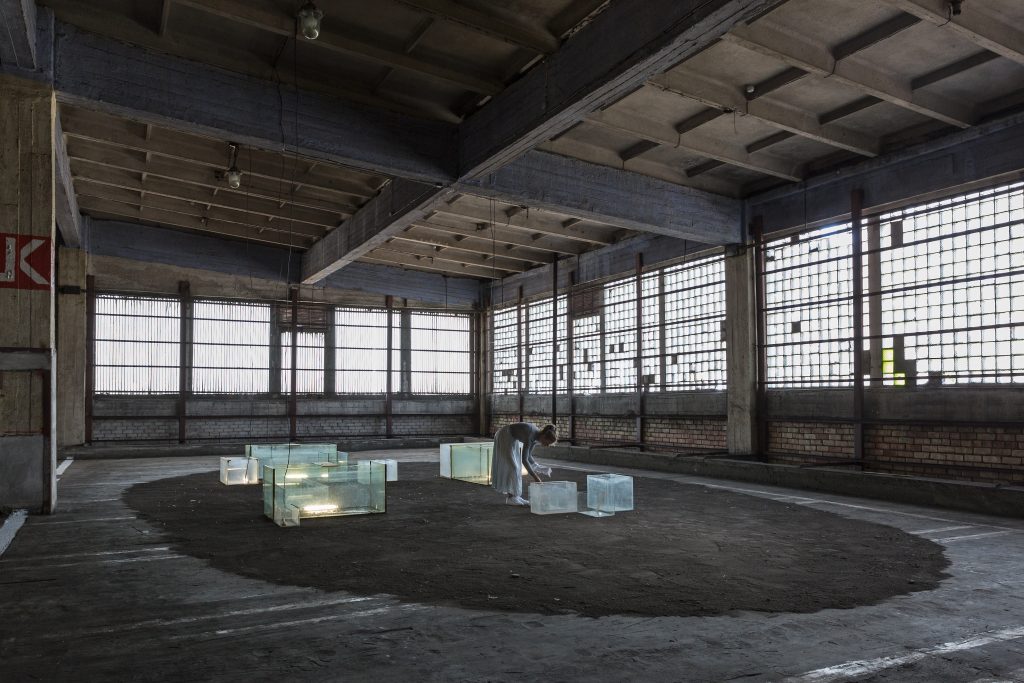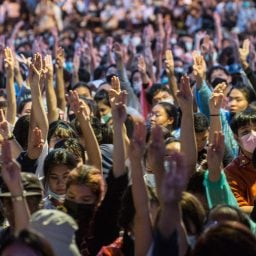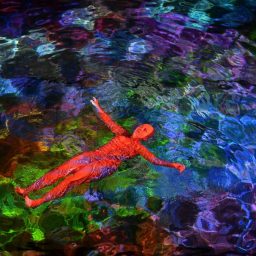Rebecca Lamarche-Vadel, the curator of the second Riga biennale, RIBOCA2, labored for two years with her team to mount an exhibition whose topic would be, in a nutshell, finding hope in the face of the end of the world. They did not expect that a mere two months before the biennial’s opening they would actually face the end of the world—or at least the world as they knew it.
The original format of the exhibition, which had been slated to open across several locations in the Latvian capital this past May, was thrown out the window as the Baltic country went into lockdown on March 13. Plans kept morphing as the days went by, but it soon became painfully clear that gatherings and travel would be impossible.
“But we knew this exhibition had to open this year,” RIBOCA2’s executive director, Anastasia Blokhina told journalists during a preview. “The show was about what was happening in the world!”
Her hope became a reality. The young biennial, once a stop along what would have been a clogged art calendar, now stands out as one of the lone events to take place in a year of cancelations and dashed plans. The biennial finally opened to the public in a much reduced and altered format on August 20, with members of the art world gathering at a defunct and dilapidated industrial site by Riga’s port.
The necessarily curbed ambitions of the biennial did not stop artists coming up with incisive reinventions for their planned pieces. As countries around Europe teeter towards another alarming uptick in infection rates heading into fall, RIBOCA’s title, “and suddenly it all blossoms,” hints at optimism—though Lamarche-Vadel says that the phrase contains ambiguity as well: “But what does this ‘it’ refer to?”
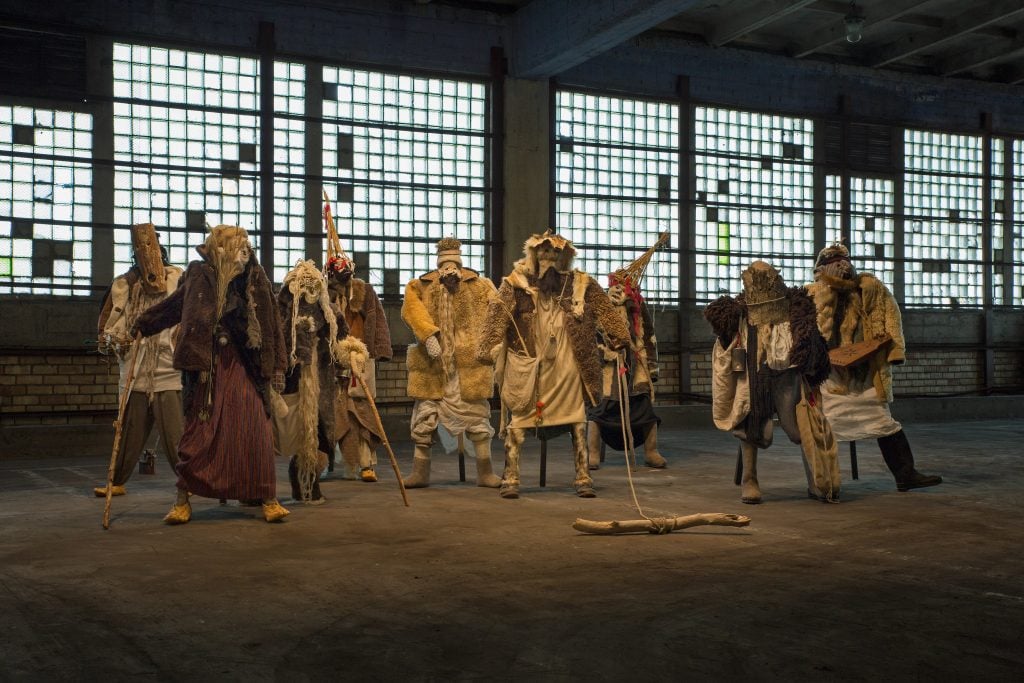
Nikolay Smirnov, Religious Libertarians (2020). Commissioned by the 2nd Riga International Biennial of Contemporary Art, RIBOCA. Photo by Hedi Jaansoo. Courtesy of the Riga International Biennial of Contemporary Art.
Curating with Covid-19
“I have to acknowledge Covid-19 as my co-curator,” Lamarche-Vadel quipped during the press preview, referring not only to the many ways in which the artworks have been altered, but also to how differently they may be interpreted. The biennial, originally planned to run for five months, will remain on view for three weeks only.
To compensate for the reduced duration, and capture the collision of its curatorial concept with reality, Lamarche-Vadel enlisted acclaimed Latvian film director Dāvis Sīmanis to produce a feature-length film on the show, with an original score by up-and-coming musician and producer Lafawndeh. The goal is to circulate it in the major film festivals and, hopefully, hold public screenings next spring and summer—abiding by whatever safety restrictions regarding large gatherings will make up the new normal by then, of course.
That RIBOCA2 could welcome visitors at all has largely to do with the fact that Latvia, and the Baltic region in general, reacted to the Covid-19 pandemic swiftly and uncompromisingly: the country went into full lockdown 11 days after the coronavirus had been confirmed to have arrived there, and reopened in late June. So far, less than 1,500 infections and 30 coronavirus-related deaths have been recorded. That good behavior certainly paid off in some respects for the biennial’s crisis planning: though the biennial consists of 85 percent new commissions, 60 percent of the artists are based in the Baltic region.
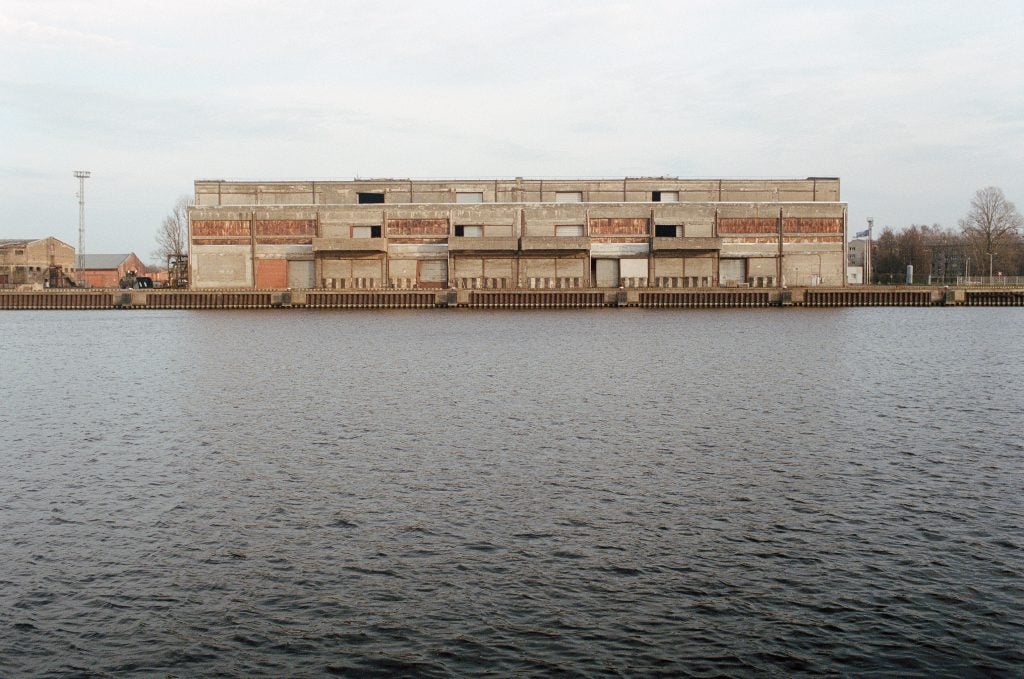
RIBOCA2 port building venue at Andrejsala. Photos by Elena Kononova.
A Balancing Act
But the Baltic nations’ precautionary measures were not the only reason why the opening was possible. Lamarche-Vadel, who is the director of the Fondation Lafayette Anticipations in Paris, had already shaped the curatorial concept around imagining new ways of being in the world, focusing on the preservation of resources and the abandonment of extractive industries. Most of the 48 participating artists’ works were originally planned to be produced locally rather than shipped across the globe. By the time lockdown had been enforced, several of the works were ready.
Pieces that couldn’t be shipped were adapted to the new conditions. Ugo Rondinone’s wall installation Life Time, from the artist’s series of larger-than-life neon “rainbow poems,” didn’t make it over from Switzerland. Instead, it was recreated locally with plywood, and painted the colors of the rainbow flag on-site. It hangs over a small doorway cut into a brick wall in an enormous hangar, like an inscription over a gateway to the biennial’s sprawling post-industrial site.
Behind that wall, US artist Bridget Polk presents an arrangement of temporary sculptures. As its title suggests, the installation Balancing Rocks and Rubble is made of rocks and construction debris stacked on top of each other without using glue or any reinforcement other than gravity. Potentially unstable, the enchanting formations could collapse at any moment.
About a decade ago, Polk received the moniker “Rock Lady” as fans would gather to watch her balance rocks along the banks of the Hudson River. Recovering from addiction at the time, stacking became a meditative practice for her. She’s one of the few artists who traveled to Riga from the United States (an odyssey involving many stops and emergency calls to the Latvian team at every border) and here she will continue to stack—or sometimes purposely topple over—heavy rubble collected on location for the next three weeks.
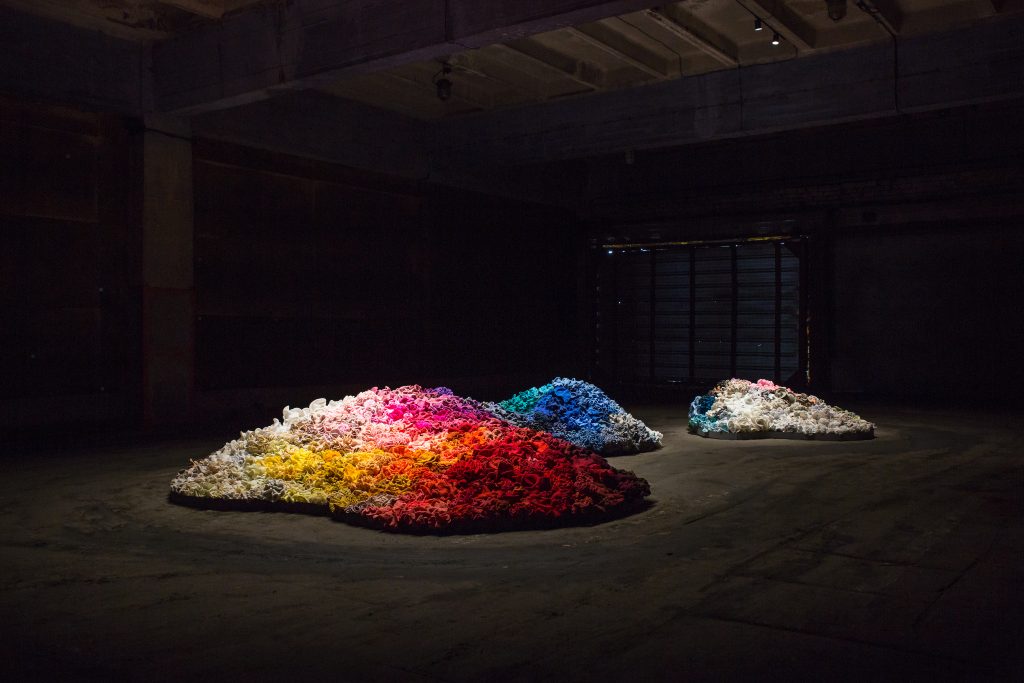
Daina Taimiņa Dreams and Memories (2020). Commissioned by the 2nd Riga International Biennial of Contemporary Art, RIBOCA2. Photo by Heidi Jaansoo. Courtesy of the Riga International Biennial of Contemporary Art.
New Ecosystems
Today, stray cats and street dogs roam the abandoned industrial complex, Andrejsala, its grounds overgrown with wild weeds and plants. Some of the biennial’s works pay tribute to the flora and fauna. Vija Enina, a Latvian herbalist, seed bombed the premises in late winter. As visitors walk through the open-air section of the show, they might notice the aromatic verdure sprouting from the cracks in the asphalt.
Elsewhere, a pack of dogs replaces the humans who were supposed to be cast for Dora Budor’s work, now retitled In The Year Of (companion piece). The artist had intended to direct a group of “extras” to gather at random, as a nod to the dystopian site’s cinematic qualities. Now, four-legged creatures gather around a trainer with a bag of treats.
Meanwhile, Danish artist Nina Beier’s installation Total Loss includes two marble lions, of the variety found in entrances to neo-classical mansions, lying on their side. Milk, an offering for the site’s feral cats, is regularly poured into the statues’ crevices. The use of milk is telling: our economies are designed to milk every resource; factory farming and dairy production are among the highest sources of CO2 emissions.
But there’s more to the allegory of Total Loss. Beier’s installation was accompanied by a one-time performance on August 22, in which Range Rovers, parked outside the port building, offer shelter for a group of pregnant women. This pairing of one of the most wasteful vehicles ever designed and women about to bring children into an overpopulated world could be read as a comment on the bleak future of a human race obsessed with market growth.
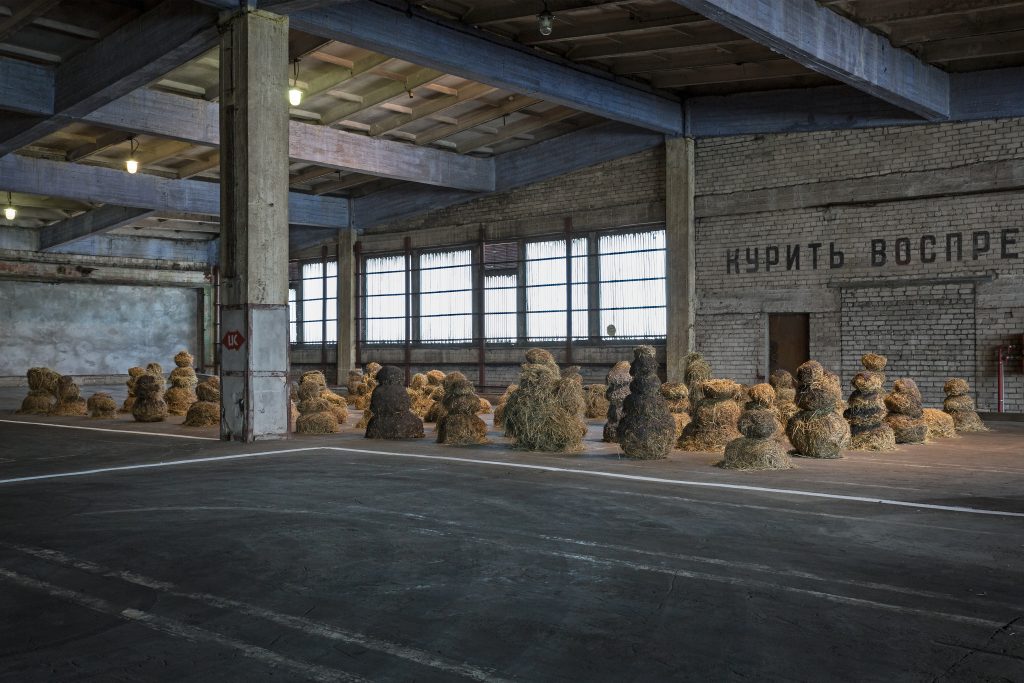
Augustas Serapinas, Mudmen (2020). Commissioned by the 2nd Riga International Biennial of Contemporary Art. RIBOCA2. Photo by Hedi Jaansoo. Courtesy of the Riga International Biennial of Contemporary Art.
To be sure, the adaptability of artists and the art world will become increasingly important in the years to come. Lithuanian artist Augustas Serapinas also had to deal with botched plans for his site-specific installation for the biennial, but not because of the pandemic. He initially devised a plan to hang around snowy parks with a group of assistants and wait for people to build snowmen and then scoop up the icy creations, sneak them into van, and scan them to be replicated in other materials before returning them to their original spots.
But it never snowed in Latvia due to record-high temperatures that hit Europe this year, and so Serapinas’s legion of Mudmen—a multitude of bulbous stacks of mud and hay—stand in their place. It’s an important reminder of what Lamarche-Vadel was already chipping away at before the pandemic brought it all into focus: Covid-19 may be an agitator, but the old world was already slipping away. It’s high time to imagine a new one.
RIBOCA2, “and suddenly it all blossoms,” is on view at Andrejsala, Riga from 20 August through 13 September, 2020.
